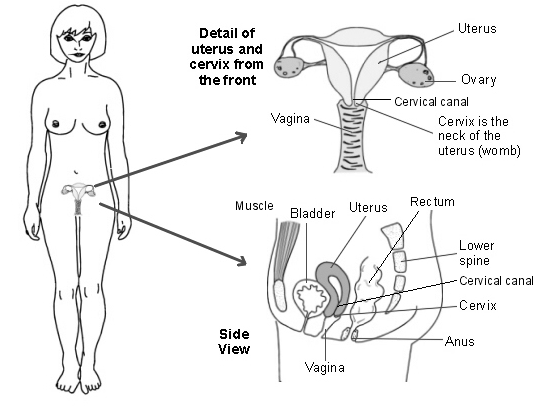What is the uterus?
The uterus (womb) is in the lower abdomen behind the bladder. The inside of the uterus is where a baby grows if you become pregnant. The inside lining of the uterus is called the endometrium. This builds up and is then is shed each month as a 'period' in women who have not yet gone through the menopause. The thick body of the uterus is called the myometrium and is made of specialised muscle tissue.
The lowest part of the uterus is called the cervix which pushes just into the top part of the vagina. At the top of the uterus are the right and left fallopian tubes which carry the eggs released from the ovaries to the inside of the uterus.
What is cancer?
Cancer is a disease of the cells in the body. The body is made up from millions of tiny cells. There are many different types of cell in the body, and there are many different types of cancer which arise from different types of cell. What all types of cancer have in common is that the cancer cells are abnormal and multiply 'out of control'.
A malignant tumour is a 'lump' or 'growth' of tissue made up from cancer cells which continue to multiply. Malignant tumours invade into nearby tissues and organs which can cause damage.
Malignant tumours may also spread to other parts of the body. This happens if some cells break off from the first (primary) tumour and are carried in the bloodstream or lymph channels to other parts of the body. These small groups of cells may then multiply to form 'secondary' tumours (metastases) in one or more parts of the body. These secondary tumours may then grow, invade and damage nearby tissues, and spread again.
Some cancers are more serious than others, some are more easily treated than others (particularly if diagnosed at an early stage), some have a better outlook (prognosis) than others.
So, cancer is not just one condition. In each case it is important to know exactly what type of cancer has developed, how large it has become, and whether it has spread. This will enable you to get reliable information on treatment options and outlook. See separate leaflet called 'What are Cancer and Tumours' for further details about cancer in general.

What is cancer of the uterus?
Most cancers of the uterus develop from cells in the endometrium (endometrial cancer). Cancer developing from muscle cells in the myometrium (uterine sarcomas) are rare and are not dealt with further in this leaflet. Cancer of the cervix is quite different to uterine cancer and is dealt with in a separate leaflet.
The rest of this leaflet deals only with endometrial cancer of the uterus.
Endometrial cancer
About 5000 women in the UK develop endometrial cancer each year. Most cases develop in women in their 50s and 60s. It rarely develops in women under the age of 50.
Type and grade of endometrial cancer
Most cases of endometrial cancer are called 'endometrioid adenocarcinomas'. These arise from cells which form the glandular tissue in the lining of the endometrium. A sample of cancer tissue can be looked at under the microscope. By looking at certain features of the cells the cancer can be 'graded'.
There are also some rarer types of endometrial cancer.
What causes endometrial cancer?
A cancerous tumour starts from one abnormal cell. The exact reason why a cell becomes cancerous is unclear. It is thought that something damages or alters certain genes in the cell. This makes the cell abnormal and multiply 'out of control'. (See separate leaflet called 'What Causes Cancer' for more details.)
There are 'risk factors' which are known to increase the risk of endometrial cancer developing. These include the following.
What are the symptoms of endometrial cancer?
In most cases the first symptom to develop is abnormal vaginal bleeding such as:
An early symptom in some cases is pain during or after having sex, vaginal discharge, and pain in the lower abdomen.
All of the above symptoms can be caused by various other common conditions. But if you develop any of these symptoms, you should have it checked out by a doctor.
In time, if the cancer spreads to other parts of the body, various other symptoms can develop.
How is endometrial cancer diagnosed and assessed?
To confirm the diagnosis
A doctor will usually do a vaginal examination if you have symptoms which may possibly be due to endometrial cancer. He or she may feel an enlarged uterus. However, even if the examination is normal, if endometrial cancer is suspected you will usually need to have a further test to confirm the diagnosis, usually one of the following:
You may also have an ultrasound scan of the uterus. An ultrasound scan is a safe and painless test which uses sound waves to create images of organs and structures inside your body. The probe of the scanner may be placed on your abdomen to scan the uterus. A small probe is also commonly placed inside the vagina to scan the uterus from this angle.
Assessing the extent and spread
If endometrial cancer is confirmed then further tests may be advised to assess if the cancer has spread. For example, a CT scan, an MRI scan, a chest x-ray, blood tests, an examination under anaesthetic of the uterus, bladder or rectum, or other tests. (There are separate leaflets which describe most of these tests in more detail.) This assessment is called 'staging' of the cancer. The aim of staging is to find out:
Finding out the stage of the cancer helps doctors to advise on the best treatment options. It also gives a reasonable indication of outlook (prognosis). See separate leaflet called 'Cancer Staging and Grading' for details.